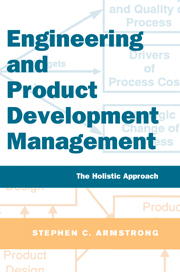Book contents
- Frontmatter
- Contents
- List of figures and tables
- Forewords
- Preface
- Acknowledgments
- Layout of book at a glance
- PART 1 UNDERSTANDING ENGINEERING PROCESS MANAGEMENT
- 1 The holistic approach to managing engineering operations
- 2 An overview of engineering process management
- 3 Organization of engineering tasks
- PART 2 APPLYING ENGINEERING PROCESSES TO PROGRAM MANAGEMENT
- PART 3 DEPLOYING ENGINEERING PROCESS MANAGEMENT
- PART 4 APPENDIXES
- Glossary
- References
- Index
2 - An overview of engineering process management
Published online by Cambridge University Press: 05 April 2014
- Frontmatter
- Contents
- List of figures and tables
- Forewords
- Preface
- Acknowledgments
- Layout of book at a glance
- PART 1 UNDERSTANDING ENGINEERING PROCESS MANAGEMENT
- 1 The holistic approach to managing engineering operations
- 2 An overview of engineering process management
- 3 Organization of engineering tasks
- PART 2 APPLYING ENGINEERING PROCESSES TO PROGRAM MANAGEMENT
- PART 3 DEPLOYING ENGINEERING PROCESS MANAGEMENT
- PART 4 APPENDIXES
- Glossary
- References
- Index
Summary
In Chapter 1, we introduced the six bodies of knowledge that are the foundation of good engineering management. This chapter outlines the key elements and critical steps necessary to implement process management concepts. We will use a process framework to structure the product definition engineering (define) process. Tailoring these processes should be based on customer, program, and business needs. However, certain fundamentals such as multifunctional teams, timely communication, integrated master plans, integrated master schedules, team colocation, and empowerment, should be applied on all of your company's programs.
This chapter looks at how to structure the Define process to help achieve business objectives. To this end, we discuss the work breakdown structure, the process framework, the structure of customer deliverables, the use of product maturity gates to control design quality, and the organization of engineering documentation.
ENGINEERING PROCESS FRAMEWORK
The approach to engineering design is based on aligning activities to the process framework. Years of experience have shown that every engineering project follows a similar path from initiation to completion. We know that no two projects or programs follow exactly the same path; however, defining this general process framework provides the foundation for engineering process management, upon which the detailed components have been developed.
Table 2-1 (see Appendix B) shows a process framework with its objectives and major deliverables (ex: Design Documentation) for each of the phases, and Table 2-2 (see Appendix B) identifies the descriptions and deliverables for each of the subphases in the process framework.
Information
- Type
- Chapter
- Information
- Engineering and Product Development ManagementThe Holistic Approach, pp. 24 - 41Publisher: Cambridge University PressPrint publication year: 2001
